|
Titans of Industry
by Bob Brooke
Before the start of the
Industrial Age in America, industry existed on a small scale. There were
no factories, no large-scale production, no super wealthy company
owners. In the 18th century, wealth came from owning land, the more
land, the wealthier the owner. But in the 19th century that all changed.
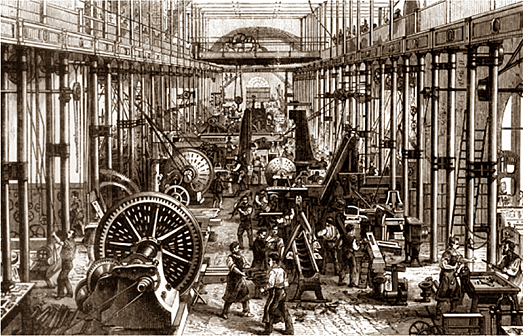
For the first time in America’s history, wealth came from business and
commercial enterprises. Owners like Andrew Carnegie and Cornelius
Vanderbilt became some of the wealthiest men in the country and titans
of American industry from their business dealings and investments.
Andrew Carnegie
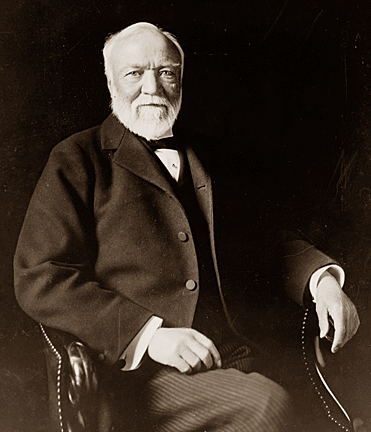 In
1848 at the age of 12, Andrew Carnegie immigrated to America from
Scotland with his parents and settled in Allegheny, Pennsylvania. He
began working as a bobbin boy at the Anchor Cotton Mills in Pittsburgh,
Pennsylvania, where he changed spools of thread 12 hours a day, 6 days a
week for $1.20 per week. In
1848 at the age of 12, Andrew Carnegie immigrated to America from
Scotland with his parents and settled in Allegheny, Pennsylvania. He
began working as a bobbin boy at the Anchor Cotton Mills in Pittsburgh,
Pennsylvania, where he changed spools of thread 12 hours a day, 6 days a
week for $1.20 per week.
In 1849, Carnegie took a job as a telegraph messenger boy in the
Pittsburgh Office of the Ohio Telegraph Company, at $2.50 per week. He
was a hard worker and memorized the locations of Pittsburgh's businesses
and the executives that worked for them.
He quickly learned to distinguish the differing sounds the incoming
telegraph signals produced and developed could translate signals by ear,
without the use of paper. Within a year, the company promoted him to
operator.
Carnegie didn’t attend school. Instead, he borrowed books from James
Anderson, a retired army officer. His capacity, his willingness for hard
work, his perseverance and his alertness soon brought him opportunities.
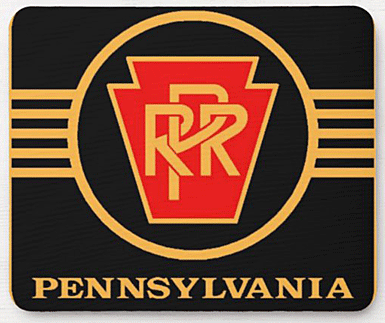 n
1853, he started a new job with the Pennsylvania Railroad, since he
believed the railroad offered more career opportunities. His employment
by the Pennsylvania Railroad Company would be vital to his later
success. n
1853, he started a new job with the Pennsylvania Railroad, since he
believed the railroad offered more career opportunities. His employment
by the Pennsylvania Railroad Company would be vital to his later
success.
By the 1860's, Carnegie had slowly accumulated capital by investing
through inside trading in companies associated with the
railroad---railroad sleeping cars, bridges, and oil derricks—and
furthered his wealth as a bond salesman.
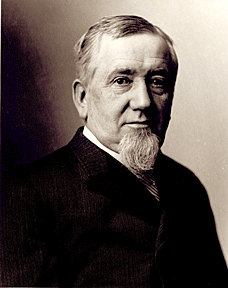 Before
the Civil War, Carnegie arranged a merger between a sleeping car company
owned by Theodore Tuttle Woodruff and that of George Pullman, the
inventor of a sleeping car for first class travel, which facilitated
business travel at distances over 500 miles. The investment proved a
success. Before
the Civil War, Carnegie arranged a merger between a sleeping car company
owned by Theodore Tuttle Woodruff and that of George Pullman, the
inventor of a sleeping car for first class travel, which facilitated
business travel at distances over 500 miles. The investment proved a
success.
In 1864, Carnegie was one of the early investors in the Columbia Oil
Company in Venango County, Pennsylvania. In one year, the farm yielded
over $1,000,000 in cash dividends, and petroleum from oil wells on the
property sold profitably. The demand for iron products, such as armor
for gunboats, cannons, and shells, as well as a hundred other industrial
products, made Pittsburgh a center of wartime production. Carnegie
worked with others in establishing a steel rolling mill, and steel
production and control of industry became the source of his fortune.
After the war, Carnegie left the railroads to devote his energies to
developing
several ironworks, eventually forming the Keystone Bridge Works and the
Union Ironworks, in Pittsburgh. Although he had left the Pennsylvania
Railroad Company, he remained connected to its management and used this
connection to obtain contracts for his Keystone Bridge Company and the
rails produced by his ironworks. The Pennsylvania R.R. became his best
customer.
Andrew Carnegie made his fortune in the steel industry, controlling the
most extensive integrated iron and steel operations ever owned by an
individual in the United States. One of his two great innovations was in
the cheap and efficient mass production of steel by adopting and
adapting the Bessemer process, which allowed the high carbon content of
pig iron to be burnt away in a controlled and rapid way during steel
production. Steel prices dropped as a result, and the railroads quickly
adopted Bessemer steel for their rails.
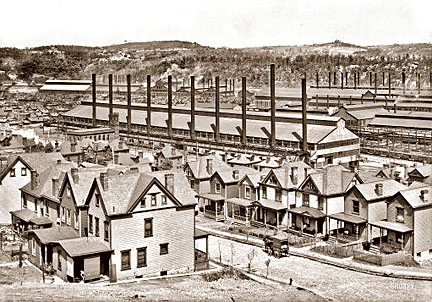 His
second innovation was his vertical integration of all suppliers of raw
materials. In the late 1880s, Carnegie Steel was the largest
manufacturer of pig iron, steel rails, and coke in the world, with a
capacity to produce approximately 2,000 tons of pig metal per day. In
1883, Carnegie bought the rival Homestead Steel Works, which included an
extensive plant served by tributary coal and iron fields, a 425-mile
long railway, and a line of lake steamships. Carnegie combined his
assets and those of his associates in 1892 with the launching of the
Carnegie Steel Company. (Read “Iron—The Material of the Industrial
Age.”) His
second innovation was his vertical integration of all suppliers of raw
materials. In the late 1880s, Carnegie Steel was the largest
manufacturer of pig iron, steel rails, and coke in the world, with a
capacity to produce approximately 2,000 tons of pig metal per day. In
1883, Carnegie bought the rival Homestead Steel Works, which included an
extensive plant served by tributary coal and iron fields, a 425-mile
long railway, and a line of lake steamships. Carnegie combined his
assets and those of his associates in 1892 with the launching of the
Carnegie Steel Company. (Read “Iron—The Material of the Industrial
Age.”)
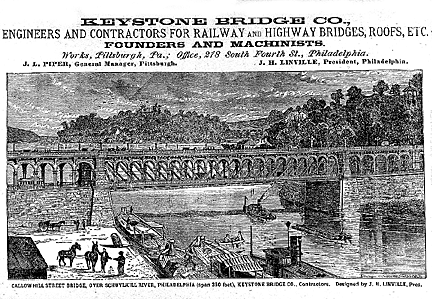 By
1889, the U.S. output of steel exceeded that of the UK, and Carnegie's
empire grew to include the J. Edgar Thomson Steel Works in Braddock,
Pittsburgh Bessemer Steel Works, the Lucy Furnaces, the Union Iron
Mills, the Union Mill, the Keystone Bridge Works, the Hartman Steel
Works, the Frick Coke Company, and the Scotia ore mines. By
1889, the U.S. output of steel exceeded that of the UK, and Carnegie's
empire grew to include the J. Edgar Thomson Steel Works in Braddock,
Pittsburgh Bessemer Steel Works, the Lucy Furnaces, the Union Iron
Mills, the Union Mill, the Keystone Bridge Works, the Hartman Steel
Works, the Frick Coke Company, and the Scotia ore mines.
In 1901, John Pierpont Morgan proposed a buyout of Carnegie’s steel
assets. The resultant transaction produced the first integrated steel
company, United States Steel Corporation, worth over $1 billion at the
time. The buyout was the largest such industrial takeover in the United
States up to that time.
During the last 18 years of his life, he gave away $350 million—almost
90 percent of his fortune—to charities, foundations, and universities,
making him one of the leading philanthropists of his day.
Cornelius Vanderbilt
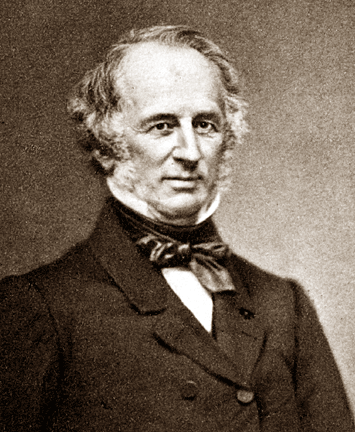 Like
Carnegie, Cornelius Vanderbilt began his meteoric rise to wealth early
in life. After quitting school at 11, he started a small ferry business
at 16, borrowing $100 from his mother to purchase a periauger, a shallow
draft, two-masted sailing vessel to ferry freight and passengers between
Staten Island and Manhattan. He was so energetic that other captains
began calling him “The Commodore.” Like
Carnegie, Cornelius Vanderbilt began his meteoric rise to wealth early
in life. After quitting school at 11, he started a small ferry business
at 16, borrowing $100 from his mother to purchase a periauger, a shallow
draft, two-masted sailing vessel to ferry freight and passengers between
Staten Island and Manhattan. He was so energetic that other captains
began calling him “The Commodore.”
Eventually, he purchased his brother-in-law’s schooner, “Charlotte,” and
began trading in food and merchandise. Thomas Gibbons, another ferry
operator, asked Vanderbilt to captain his steamboat between New Jersey
and New York. Although Vanderbilt kept his own businesses running, he
became Gibbons's business manager. When Gibbons died, Vanderbilt stayed
on with Gibbons's son, and then bought him out.
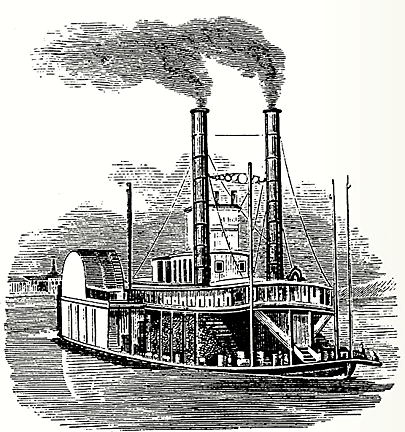 Little
by little, Vanderbilt gained control of the ferry lines around New York
City and created a secret monopoly by having an under-the-table
partnership with a rival company. He then became involved with the
railroads, since their routes often relied on steamships. Little
by little, Vanderbilt gained control of the ferry lines around New York
City and created a secret monopoly by having an under-the-table
partnership with a rival company. He then became involved with the
railroads, since their routes often relied on steamships.
In 1834, Vanderbilt competed on the Hudson River against the Hudson
River Steamboat Association, a steamboat monopoly between New York City
and Albany. At the end of the year, the monopoly paid him a large amount
to stop competing, and he switched his operations to Long Island Sound.
Some of the first railroads built in the United States ran from Boston
to Long Island Sound to connect with steamboats that ran to New York. By
the end of the decade, Vanderbilt dominated the steamboat business on
the Sound and began to take over management of the connecting railroads.
In the 1840s, he launched a campaign to take over the most attractive of
these lines, the New York, Providence and Boston Railroad, popularly
known as the Stonington. By cutting fares on competing lines, Vanderbilt
drove down the Stonington stock price, and took over the presidency of
the company in 1847.
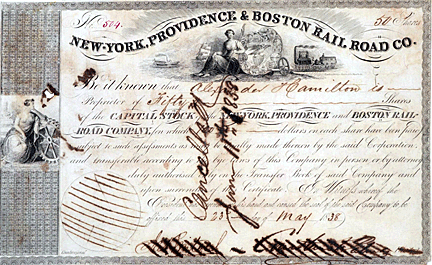
Meanwhile, he purchased large amounts of real estate in Manhattan and
Staten Island. Then he took over the Staten Island Ferry in 1838.
When the California gold rush began in 1849, Vanderbilt switched from
regional steamboat lines to ocean-going steamships. Many of the migrants
to California, and almost all of the gold returning to the East Coast,
went by steamship to Panama, where mule trains and canoes provided
transportation across the isthmus.
Vanderbilt proposed a canal across Nicaragua, but he couldn’t raise
enough capital. However, he did start a steamship line to Nicaragua and
founded the Accessory Transit Company to carry passengers across
Nicaragua by steamboat on Lake Nicaragua and the San Jose River to a
12-mile carriage road between the Pacific port of San Juan del Sur and
Virgin Bay on Lake Nicaragua. He then turned his efforts to
transatlantic steamship lines.
He served on the boards of directors of the Erie Railway, the Central
Railroad of New Jersey, the Hartford and New Haven, and the New York and
Harlem in the 1850s. And in 1863, Vanderbilt took control of the Harlem.
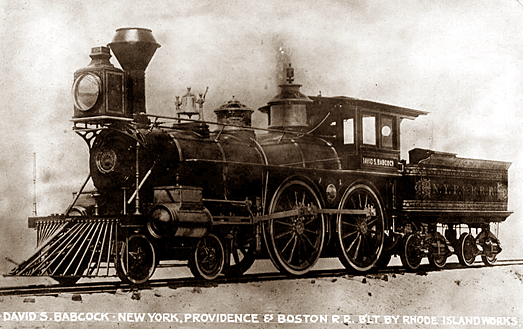
The New York and Harlem was the only steam railroad to enter the center
of Manhattan, running down 4th Avenue to a station on 26th Street, where
it connected with a horse-drawn streetcar line. From Manhattan it ran up
to Chatham Four Corners, New York, where it had a connection to the
railroads running east and west.
In 1864, the Commodore sold his last ships, in order to concentrate on
his railroads.
He bought control of the Hudson River Railroad that same year, the New
York Central Railroad in 1867, and the Lake Shore and Michigan Southern
Railway in 1869. He later purchased the Canada Southern as well. In
1870, he consolidated two of his key lines into the New York Central and
Hudson River Railroad, one of the first giant corporations in United
States history.
In 1869, Vanderbilt began construction of the Grand Central Depot on
42nd Street in Manhattan. Finished three years later, it served as his
lines' terminus in New York. He sank the tracks on 4th Avenue in a cut
that later became a tunnel, and 4th Avenue became Park Avenue. In 1913,
he replaced the depot with Grand Central Station.
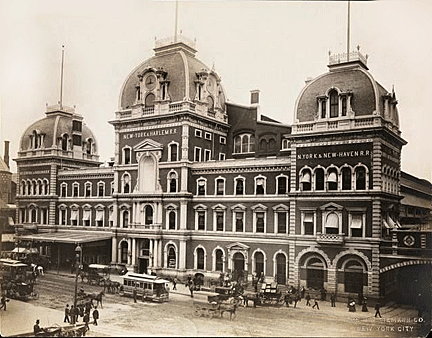
Cornelius Vanderbilt died on January 4, 1877, at his residence, No. 10
Washington Place, after having been confined to his rooms with various
chronic ailments for about eight months.
He helped to create the corporate economy that would define the United
States into the 21st century. As one of the richest Americans in history
and wealthiest figures overall, Vanderbilt was the patriarch of the
wealthy and influential Vanderbilt family.
Andrew Carnegie and Cornelius Vanderbilt are just two of America’s first
millionaires. Carnegie amassed over $380 million in his lifetime while
Vanderbilt only made $185 million.
<
More Special Features
Next Article > |
